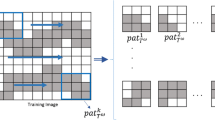Abstract
Simulation of flow and solute transport through aquifers or oil reservoirs requires a precise representation of subsurface heterogeneity that can be achieved by stochastic simulation approaches. Traditional geostatistical methods based on variograms, such as truncated Gaussian simulation or sequential indicator simulation, may fail to generate the complex, curvilinear, continuous and interconnected facies distributions that are often encountered in real geological media, due to their reliance on two-point statistics. Multiple Point Geostatistics (MPG) overcomes this constraint by using more complex point configurations whose statistics are retrieved from training images. Obtaining representative statistics requires stationary training images, but geological understanding often suggests a priori facies variability patterns. This research aims at extending MPG to non-stationary facies distributions. The proposed method subdivides the training images into different areas. The statistics for each area are stored in separate frequency search trees. Several training images are used to ensure that the obtained statistics are representative. The facies probability distribution for each cell during simulation is calculated by weighting the probabilities from the frequency trees. The method is tested on two different object-based training image sets. Results show that non-stationary training images can be used to generate suitable non-stationary facies distributions.
Similar content being viewed by others
References
Caers J (2001) Geostatistical reservoir modelling using statistical pattern recognition. J Petroleum Sci Eng 29:177–188
Caers J, Zhang T (2004) Multiple-point geostatistics: A quantitative vehicle for integrating geologic analogs into multiple reservoir models. In: Gramer M, Harris PM, Eberli GP (eds) Integration of outcrop and modern analogs in reservoir modeling. Am Assoc Petroleum Geol Memoir, 80:383–394
Carrera J (1993) An overview of uncertainties in modeling groundwater solute transport. J Contam Hydrol 13:23–48
Chugunova TL, Hu LY (2008) Multiple-point simulations constrained by continuous auxiliary data. Math Geosci 40:133–146
Deutsch CV, Hewet TA (1996) Challenges in reservoir forecasting. Math Geol 28:829–842
Deutsch CV, Journel AG (1998) GSLIB: Geostatistical Software Library and user’s guide. Oxford University Press, New York. 369 p
Dowd PA, Pardo-Igúzquiza E, Xu C (2003) Plurigau: a computer program for simulating spatial facies using truncated plurigaussian method. Comput Geosci 29:123–141
Falivene O, Arbués P, Gardiner AR, Pickup GE, Muñoz JA, Cabrera L (2006) Best-pactice stochastic facies modeling from a channel-fill turbidite sandstone analog (the Quarry Outcrop, Eocene Ainsa Basin, NE Spain). Am Assoc Petroleum Geol Bull 90:1003–1029
Falivene O, Cabrera L, Muñoz JA, P. A, Fernández O, Saez A (2007) Statistical grid-based facies reconstruction and modelling for sedimentary bodies. Alluvial-palustrine and turbiditic examples. Geol Acta 5:199–230
Galli A, Beucher H, Le Loc’h G, Doliguez, Heresim Group (1994), The pros and cons of the truncated Gaussian method. In: Armstrong M, Dowd PA (eds) Geostatistical simulations, pp 217–233
Guardiano F, Srivastava RM (1993) Multivariate geostatistics: beyond bivariate moments. In: Soares A (ed) Geostatistics-Troia. Kluwer, Dordrecht, pp 133–144
Haldorsen HH, Damsleth E (1990) Stochastic modeling. J Petroleum Geol 42:404–412
Journel AG, Deutsch CV (1993) Entropy and spatial disorder. Math Geol 25:329–355
Journel AG, Isaaks EH (1984) Conditional indicator simulation: Application to a Saskatchewan uranium deposit. Math Geol 16:685–718
Journel A (1985) The deterministic side of geostatistics. Math Geol 17:1–15
King MJ, Mansfield M (1999), Flow simulation of geologic models. Society of Petroleum Engineers Reservoir Eval. & Eng, vol 2 (SPE Paper number 57469)
Knudby C, Carrera J (2005) On the relationship between indicators of geostatistical, flow and transport connectivity. Adv Water Resour 28:405–421
Koltermann CE, Gorelick SM (1996) Heterogeneity in sedimentary deposits: A review of structure-imitating, process-imitating, and descriptive approaches. Water Resour Res 32:2617–2658
Liu Y (2006) Using the Snesim program for multiple-point statistical simulation. Comput Geosci 32:1544–1563
Liu GS, Zheng CM, Gorelick SM (2004a) Limits of applicability of the advection-dispersion model in aquifers containing connected high-conductivity channels. Water Resour Res. doi: 10.1029/2003WR002735
Liu Y, Harding A, Abriel W, Strebelle S (2004b) Multiple-point simulation integrating wells, three-dimensional seismic data, and geology. Am Assoc Petroleum Geol Bull 88:905–921
de Marsily G, Delay F, Teles V, Schafmeister MT (1998) Some current methods to represent the heterogeneity of natural media in hydrogeology. Hydrogeol J 6:115–130
Pardo-Igúzquiza E, Dowd PA (2003) CONNEC3D: a computer program for connectivity analysis of 3D random set models. Comput Geosci 29:775–785
Pryor WA (1973) Permeability-porosity patterns and variations in some holocene sand bodies. Am Assoc Petroleum Geol Bull 57:162–189
Slooten L, Batlle F, Carrera J, Gamazo P, De Vries LM (2007), Prosit manual: Getting started
Strebelle S (2002) Conditional simulation of complex geological structures using multiple-point statistics. Math Geol 34:1–22
Strebelle S, (2006), Sequential simulation for modeling geological structures from training images. In: Yarus JM, Chambers RL (eds) Stochastic modelling and geostatistics: Principles, methods and case studies, vol 2, pp 139–149
Strebelle S, Payrazyan K, Caers J (2002) Modeling of a deepwater turbidite reservoir conditional to seismic data using multiple-point geostatistics. Society of Petroleum Engineers Paper number 77425, 10 p
Tetzlaff DM, Harbaugh JW (1989) Simulating clastic sedimentation. Van Nostrand Reinhold, New York. 202 p
Wu J (2007) 4D Seismic and multiple-point pattern data integration using geostatistics. PhD Thesis, Energy Resources Engineering Department, Stanford University (California, USA), 275 p
Xu W (1996) Conditional curvilinear stochastic simulation using pixel-based algorithms. Math Geol 28:937–950
Author information
Authors and Affiliations
Corresponding author
Rights and permissions
About this article
Cite this article
de Vries, L.M., Carrera, J., Falivene, O. et al. Application of Multiple Point Geostatistics to Non-stationary Images. Math Geosci 41, 29–42 (2009). https://doi.org/10.1007/s11004-008-9188-y
Received:
Accepted:
Published:
Issue Date:
DOI: https://doi.org/10.1007/s11004-008-9188-y




